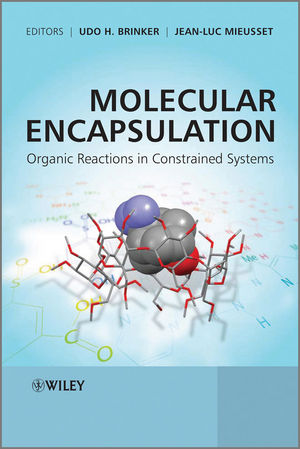Molecular Encapsulation: Organic Reactions in Constrained SystemsISBN: 978-0-470-99807-6
Hardcover
520 pages
August 2010
 |
||||||
List of Contributors.
1 Reaction Control by Molecular Recognition – A Survey from the Photochemical Perspective (Cheng Yang, Chenfeng Ke, Yu Liu, and Yoshihisa Inoue).
1.1 Introduction.
1.2 Photochemical Reactions Mediated by Macrocyclic Compounds.
1.3 Photochemical Reactions with Biomolecules.
1.4 Photochemical Reactions with Confined Cages Based on Inorganic and Organic–Inorganic Hybrid Materials.
1.5 Photochemical Reactions with other Artificial Hosts.
1.6 Photoreaction Control by External Variants.
1.7 Conclusions.
2 Cyclodextrins (Ronald Breslow).
2.1 Introduction.
2.2 Acylations of the Cyclodextrins by Bound Substrates.
2.3 Catalytic Reactions in Cyclodextrin Cavities: Aromatic Substitution.
2.4 Other Solvents than Water.
2.5 Catalytic Reactions Produced by Cyclodextrins With Covalently Attached Catalytic Groups.
2.6 Binding by Cyclodextrins and their Dimers and Trimers.
2.7 Mimics of Enzymes that Use Thiamine Pyrophosphate as a Co-Enzyme.
2.8 Aldol Condensations Catalysed by Cyclodextrin Derivatives.
2.9 Mimics of Enzymes Using Coenzyme B12 as a Cofactor.
2.10 Mimics of Cytochrome P-450.
3 Cyclodextrins as Molecular Reactors (Christopher J. Easton and Hideki Onagi).
3.1 Introduction.
3.2 Regiocontrolled Electrophilic Aromatic Substitutions.
3.3 Catalysis of Hydrolytic Reactions.
3.4 A Molecular Reactor for the Synthesis of Indigoid Dyes.
3.5 Manipulation of Cycloadditions.
3.6 Conclusion.
4 Reactions Mediated by Cyclodextrins (Keiko Takahashi).
4.1 Introduction.
4.2 The Inclusion Phenomena of Cyclodextrins.
4.3 Origin of Microvessels as Molecular Flasks.
4.4 Organic Reactions Mediated by CD in Water.
4.5 Conclusion.
5 Reactions in Zeolites (Stéphane Walspurger and Jean Sommer).
5.1 The Confi nement Effect.
5.2 Superelectrophilic Activation in Zeolites.
5.3 Huisgen [3+2]-Cycloadditions.
5.4 Multicomponent Reactions.
5.5 Conclusion.
6 Chemistry in Self-Assembled Nanoreactors (Jarl Ivar van der Vlugt, Tehila S. Koblenz, Jeroen Wassenaar, and Joost N. H. Reek).
6.1 Introduction.
6.2 Self-Assembled Nanocapsules.
6.3 Encapsulation Effects in Catalysis.
6.4 Hydrogen Bonded Capsules.
6.5 Capsules Based on Metal–Ligand Interactions.
6.6 Tetrahedral Cages Based on Octahedral M3+ Ions.
6.7 Octahedral and Square Pyramidal Cages Based on Square-Planar M2+ Ions.
6.8 Hydrophobic Effects as the Driving Force for the Self-Assembly of Nanocapsules.
6.9 Ligand Template Approach Using Lewis Acid/Base Interactions.
6.10 Virus Capsids, Proteins and Micellar Systems.
6.11 Micellar Systems.
6.12 Conclusions and Outlook.
7 Concave Reagents (Ulrich Lüning).
7.1 Introduction.
7.2 Classes of Concave Reagents.
7.3 Reactions and Catalyses.
7.4 Summary and Outlook.
8 Reactivity Control by Calixarenes (Luigi Mandolini, Roberta Cacciapaglia, and Stefano Di Stefano).
8.1 Introduction.
8.2 Calixarenes as Hosts.
8.3 Calixarenes as Molecular Platforms.
8.4 Concluding Remarks.
9 Reactions Inside Carcerands (Ralf Warmuth).
9.1 Introduction.
9.2 Types of Inner Phase Reactions.
9.3 Probing the Properties of the Inner Phase.
9.4 Through-Shell Reactions.
9.5 Intramolecular Thermal Reactions.
9.6 Inner Phase Photochemistry.
9.7 Conclusions and Outlook.
10 Encapsulation of Reactive Intermediates (Jean-Luc Mieusset and Udo H. Brinker).
10.1 Introduction.
10.2 Encapsulation of Labile Species.
10.3 Isolation of Non-covalently Bonded Aggregates.
10.4 Inclusion of Reactive Intermediates.
11 Dye Encapsulation (Jeremiah J. Gassensmith, Easwaran Arunkumar, and Bradley D. Smith).
11.1 Introduction.
11.2 Reversible Dye Encapsulation Inside Organic Container Molecules.
11.3 Reversible Dye Encapsulation by Biological Receptors.
11.4 Permanent Dye Encapsulation Inside Rotaxanes.
11.5 Permanent Encapsulation Inside Inorganic Matrices.
11.6 Conclusion.
12 Organic Cations in Constrained Systems (Werner Abraham and Lutz Grubert).
12.1 Introduction.
12.2 Host–guest Complexes with Organic Cations.
12.3 Extended Hosts and Capsules.
12.4 Cucurbiturils.
12.5 Complex Systems and Applications.
12.6 Conclusions.
13 Proteins as Host for Enantioselective Catalysis: Artificial Metalloenzymes Based on the Biotin–Streptavidin Technology (Jincheng Mao and Thomas R. Ward).
13.1 Introduction.
13.2 The Biotin–Avidin Technology.
13.3 Artifi cial Hydrogenases.
13.4 Artifi cial Allylic Alkylases.
13.5 Artifi cial Transfer Hydrogenase.
13.6 Enantioselective Sulfoxidation Based on Vanadyl-loaded Streptavidin 372
13.7 Conclusions and Outlook.
14 Chemical Reactions with RNA and DNA Enzymes (Andres Jäschke).
14.1 Introduction.
14.2 Catalysis by Naturally Occurring Ribozymes.
14.3 How to Generate Artifi cial RNA and DNA Catalysts.
14.4 The Catalytic Spectrum of Artifi cial Ribozymes.
14.5 Deoxyribozymes – DNA Molecules with Catalytic Properties.
14.6 Catalysis of C−C Bond Formation by Diels–Alderase Ribozymes.
14.7 Conclusion.
15 Reactions in Supramolecular Systems (Lucia Zakharova, Alla Mirgorodskaya, Elena Zhiltsova, Ludmila Kudryavtseva, and Alexander Konovalov).
15.1 Introduction.
15.2 The Single Micellar Systems: Factors of Concentration and Micellar Microenvironment.
15.3 The Role of the Structural Factor in Supramolecular Catalytic Systems.
15.4 Binary Surfactant Systems.
15.5 Polycomponent Catalytic Systems Based on Amphiphiles and Polymers.
15.6 Conclusions.
16 Encapsulation Processes by Bilayer Vesicles (Marc C. A. Stuart and Jan B. F. N. Engberts).
16.1 Introduction.
16.2 Catalysis by Vesicles. Encapsulation of Reactants.
16.3 Liposomal Encapsulation in Drug Delivery.
16.4 Vesicle–Nucleic Acid Interactions: Gene Transfer Using Lipoplexes.
17 Reactions in Liposomes (Pasquale Stano and Pier Luigi Luisi).
17.1 Introduction.
17.2 Lipid Vesicles (Liposomes).
17.3 Experimental Strategies and Theoretical Aspects.
17.4 A Theoretical Framework for Complex Reactions in Liposomes.
17.5 Four Cases of Compartmentalized Reactions.
17.6 Conclusion.
Acknowledgements.
Abbreviations.
References.
Index.



